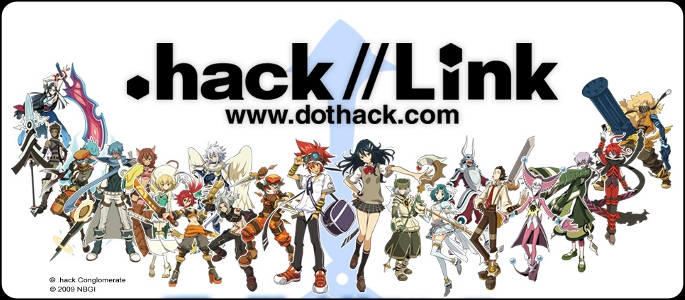Being a huge .hack fan, I’ve enjoyed its various manga, watched all the anime, and have played through all of the previous games (all of which were on PS2), so I was totally stoked for the PSP’s .hack//Link. As of 5 hours, .hack//Link was a good game. After 12 hours, it was a so-so game. After 20 hours, it was a half-decent game for diehard .hack fans, but irrelevant to anyone else. After 30 hours, it became torture. At the end of a 50-hour completion run, it now literally turns my stomach to imagine picking this game up again.
How the game took such a plunge was by being so repetitive, it actually felt more like a 50-hour demo disc with a story. Now before writing this complaint off and citing that all games require repetition, and JRPGs in particular can be notorious offenders of this, take note that I mean that .hack//Link is extremely repetitive in almost every aspect. This is not even close to being in the same ballpark as other RPGs; no, .hack//Link is truly in its own league when it comes to repetition.
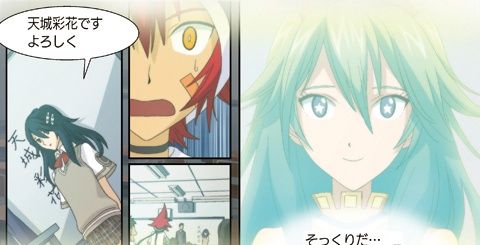
Combat in .hack//Link is more mind-numbingly repetitive as any other RPG of the generation. Tokio and his partner will use physical attacks at will, and special attacks which are doable at intervals. Actually killing an enemy with an attack, spell, or special skill, however, is uncommon. Generally in an RPG, all skills factor into finishing an enemy off; one can beat foes without having to resort to the big kill-all spell. But in .hack//Link, character combos, magic spells, and skills do incredibly little damage, even to enemies of far lower level. There is no equipment changing, so that’s not a factor; this is by design. Every enemy must have its defense broken before it can take serious damage, and this breaking usually takes several consecutive hits and combos. After its defense it broken, the player must hurry to knock it into the air, usually with the final hit of a Tokio combo. Once in the air, there’s a good chance Tokio’s ally will offer to assist in a juggle combo. This juggle is pretty much the only way to beat enemies in anything resembling a timely fashion. Even for weak monsters, who would have difficulty killing Tokio even if the player put the PSP down abruptly to make a sandwich, the player must endure the stupidly long process (for the first half of the game) of not only breaking its defense, but hitting it into the air and performing the juggle combo.
The juggle interface shows a monster head on a meter on the bottom of the screen, which will slide from right to left, from a random position and at a random speed. Hitting O when the monster head is within the specially colored area will make Tokio homerun the foe back into the air. His ally will wail on the baddy while airborne, then it will come flying towards Tokio again as the player repeats the process anywhere from 2-10 times. There’s a big green zone which constitutes a “Nice” hit and a smaller orange strip that grants a “Great” one. Tokio being better buds with a certain character will eventually make these colored strips bigger and add a yellow “Excellent” portion. Missing a hit in the combo damages Tokio, ends the combo, and restores the defense of the once-juggled enemy. The system sounds great at first, and honestly, it’s fun for the first few hours. It’s just sad that in the course of a game, nothing new is added to the battle system after the first dungeon.
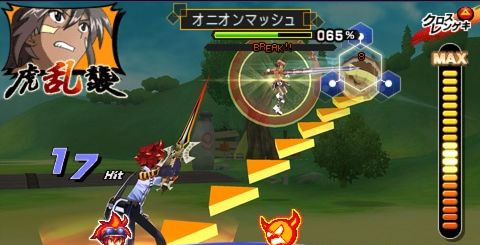
Successful juggle hits do huge damage to the enemy (really, it’s the only way to kill something doesn’t take an eternity) and work towards the ability to perform a “Cross Rengeki,” a cinematic special team attack by Tokio and his partner of the day. These 30-second unskippable sequences are pretty cool, especially the first thousand times you see them. But seeing the same thing over, and over, and over, and over again, with no option to simply skip it, gets irritating. The slapstick jokes within the sequences likewise go from amusing, to unfunny, to annoying. Want to build a good relationship and get that “Excellent” meter for juggle combos? Prepare for that character’s cinema to wear out its welcome. That hard work isn’t any sort of strategic battle or level grind in this game, it’s instead a trial of patience involving watching the same cinemas for what adds up to become hours.
Sure, unskippable, lengthy attacks exist in a few other games too — less so these days than in the PS1 era, but they’re still around once in a while. The difference is that, in general, those long, repetitive sequences were usually not the only way to kill something, unlike .hack//Link’s situation.
Dungeons follow the monotonous nature of the battle system, forcing the players to go through the same small handful of areas dozens of times each. There’s the castle, the ice place, the volcano, the field, and just a few times you’ll be in computerland. That’s it, right there. So roughly 5 hours into the game, players will have already seen every landscape and room that they will ever see. If that sounds awful, that’s because it is.
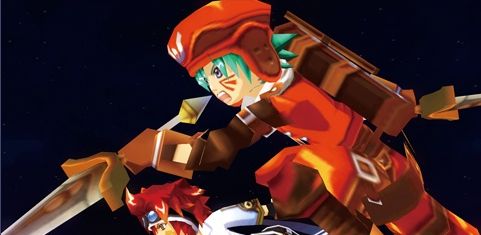
It’s not just a lack of visual variety that drags the dungeons down, however. There is no satisfaction to be had in them. No puzzles, no surprises, no interesting asides, no challenge, no alternate paths, no fun. Sometimes, there’ll be a door that requires a key. No sweat, because 100% of the time, that key is in an unguarded treasure box in the room right next to the player. So you simply run 20 feet, get the key, run back and open the door. What, exactly, was the point of that? Was that supposed to be exploration? Is this Baby’s First RPG? If this happens once or twice in a game — especially early on to get someone used to the concept — then OK, whatever, but this kind of thing goes on for the full ride through .hack//Link, which is ridiculous. Some of these design decisions teeter on insulting the intelligence of the gamer.
The end of the dungeon doesn’t mean the end of the bland cycle. Aside from a very small handful of story-centric bosses, there are only a few bosses that the player will have to continually fight again and again. Worse still, the strategy to beat them is all the same: run behind, O, O, O, keep mashing that O, juggle combo, repeat until Cross Rengeki meter becomes available. If one were to write a strategy guide for the game, that would be the boss strategy for every dungeon-ending battle.
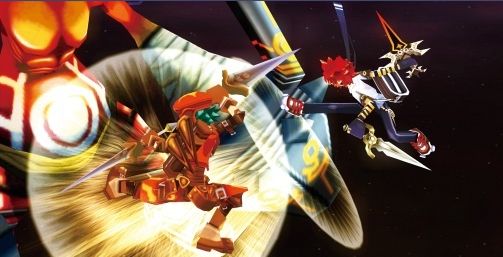
Graphics in Link are pretty much par for modern PSP titles, with the character portraits and manga sequences looking especially good. There’s an unfortunate lack of fully animated story scenes for a game whose story is clearly its strength; Link instead goes with what is more like looking at manga pages that slightly alter in real time, with characters and speech bubbles fading in and out of the backgrounds. The approach works out well enough for the game, especially since it’s got a manga tie-in. Within the game, visuals aren’t really a problem, save for the dreadful battle camera.
Which brings us to the dreadful battle camera and the disappointing battle system it worsens. .hack//Link is an action RPG like its series elders, enemies visible before they are engaged. When close enough, Tokio will automatically target an enemy. Players can change targets with the d-pad, though it won’t do much good. In a real fray, the auto-target will take over and lock onto…whatever the hell it feels like. Perhaps there’s a mage in the group Tokio is fighting, and taking it out first is the most efficient battle plan. Players will run up to it, go to the trouble of awkwardly switching targets, and start swingin’, only to find that they’re locked onto the melee fighter again. Is there a treasure chest on the battle field? Stay the hell away, because for no apparent reason, Tokio might decide to target the chest instead of an enemy — even if it’s behind him. So Tokio will be wailing away, trying to break a foe’s defense so that he can finally get the precious juggle combo, get within a hit or two, only to abruptly…open a treasure chest and get punched in the back of the head. This is not “difficulty,” this is game design failure. Difficulty and a high challenge level are great things in a game. Taking damage because the game doesn’t think you know what you want to target is frustrating and unneccessary. It’s also quite a spectacle when Tokio has an enemy directly in front of him, big ol’ target lock resting on that enemy, but the attack button somehow causes him to…do a 180-degree turn and take a swing at nothing in particular.
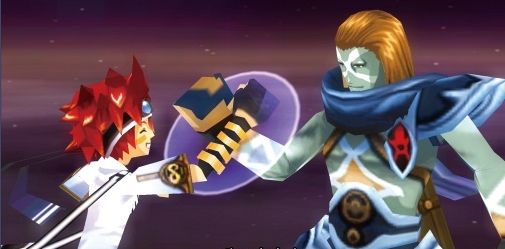
Heaven forbid there be more than two enemies on screen at once, because in a cluster, the target lock gets some serious ADD, and changes targets so rapidly, it prevents the player from getting any rhythm going at all. If it’s hard to break an enemy because of actual difficulty, that’s great. Hard games can be awesome. But when a game is “hard” because of technical slips and broken camera mechanics, that’s not game difficulty, that’s developmental failure.
The only saving grace for some people will be the fantastic story. .hack series newcomers won’t get it, but .hack//Link clearly was not intended for a new audience. All throughout the game, the story stays interesting and engaging as it retells much of the .hack story as a whole, with new twists. Players take control of a junior high school boy named Tokio in the year 2020, once again in the familiar setting of fictional MMORPG, The World. Tokio will move some events forward in the present, but also travel back in time, even to parts before .hack//Sign, as Tokio (not to be confused with the city of Tokyo) sees these legendary events for the first time and lends a helping hand. Tokio’s involvement serves to tie everything together quite well, and even in parts in which the player fully knows what to expect, the story is told so well that it usually doesn’t matter. The .hack//GU parts in particular were quite enjoyable.
Fans will also be pumped to venture into a myriad of .hack substories that had previously not been available in video game form, including .hack//Another Birth and .hack//Legend of the Twilight, just to name a couple. The roster of playable characters is huge, and the initial prospect of going on dungeon runs with so many different .hack characters should be exciting to most longtime fans.
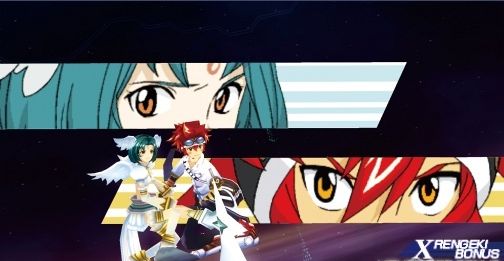
Yet, herein lies another problem. The battles you’ll fight and dungeons where you’ll be going with these characters are so bad, it kills the fun factor and deflates the experience. OK, so now you’ve got Atoli with you instead of Crim. Cool, now go do the exact same things in the exact same way, the only difference being the Cross Rengeki. The area(s) will be recycled, the boss fight will be fought in the same way with the same strategy, and for that matter, every single battle of the dungeon will look and feel just like those that came before them.
Since going out with the same character as often as possible helps build a better relationship with that character, leading to a bigger combo meter, players might want to relationship grind a little bit by bringing one character out multiple times. This gets difficult, however, as the game seems to choose the companion automatically about half the time. Worse still, the story-chosen character is often a new acquaintance of Tokio’s and is therefore starting at square one. It’s pretty disappointing to put all that work into a character’s relationship and then not have it available, due to the game choosing Tokio’s one and only companion. If this game allowed a three-member party like the previous games, this would not be a big problem, but the maximum group size is now two, meaning some amount of the player’s work will be wasted.
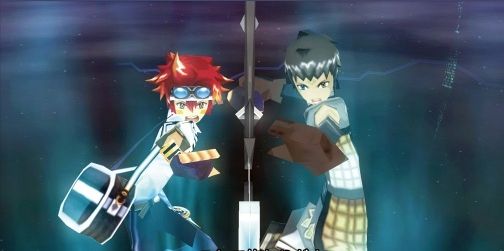
As a .hack fan, I’d constantly find myself in internal conflict during the course of Link. Certainly the story kept me wanting to move on, but the idea of actually playing the game became more and more painful.
A video game demo has a certain amount of content on it that lets a player get a small taste of a game to see if it’s to his liking or not. Game depth is, most often, much beyond what the demo shows. So imagine the disappointment if a 50-hour game shows you virtually nothing new beyond the 5 or 6-hour mark. Outside of the story, almost nothing evolves, or even changes in the slightest. Think about that. In that way, .hack//Link is very much like playing a demo with a longer story.
There are admittedly some fans out there who would probably eat this up simply because it has .hack characters and features the universe they’ve come to love so much. Subtract the .hack faces and there’s part of a game design student’s final project, and nothing actually fun to play. .hack//Link, then, is best enjoyed simply in its manga form and perhaps will make a good anime, but as a game, it falls flat.
PlayStation LifeStyle’s Final Score
-Somehow manages to be very easy, yet very frustrating due to technical flubs. |
 |
–
